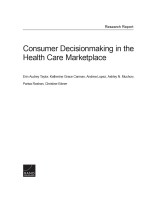| 来源类型 | Research Reports
|
| 规范类型 | 报告
|
| DOI | https://doi.org/10.7249/RR1567
|
| ISBN | 9780833095053
|
| 来源ID | RR-1567-ASPEC
|
| Consumer Decisionmaking in the Health Care Marketplace |
| Erin Audrey Taylor; Katherine Grace Carman; Andrea Lopez; Ashley N. Muchow; Parisa Roshan; Christine Eibner
|
| 发表日期 | 2016
|
| 出版年 | 2016
|
| 页码 | 98
|
| 语种 | 英语
|
| 结论 |
Consumers Suffer from Bounded Rationality and Other Biases- They might make suboptimal choices because they have difficulty processing complex information, fatigue, and other factors that limit critical thinking skills.
- Consumers are also prone to status quo bias: They stick with initial choices even if prices change or if new, potentially better choices become available.
- The order in which sites present choices significantly influences consumers' decisions.
- Consumers can be susceptible to framing biases, such that the manner in which sites describe choices can affect decisions.
Consumers Have Limited Health Literacy and Numeracy- Many people lack familiarity with such terms as deductible, coinsurance rate, and provider network. Low-income and uninsured consumers have a more-limited understanding of these concepts than higher-income and insured consumers do.
- Consumers tend to put undue emphasis on premiums in selecting plans, suggesting that they do not fully take into account the impact of cost sharing.
- Conveying information on plan quality to consumers is difficult, an issue that is at least partly related to consumers' lack of familiarity with quality metrics.
- There are many dimensions of quality, not all of which are important for every consumer, but providing detailed information on multiple quality metrics can become overwhelming. Consumers might tend to view price as a proxy for quality.
Some Options Could Improve Plan Selections- Simplifying the information presented as much as possible could improve consumer choice. People make better choices when price and quality differences are ranked using symbols instead of numbers, when information is presented graphically, and when key information can be compared side by side.
|
| 摘要 |
- Provide tools to help consumers sort and filter options.
- Provide out-of-pocket calculators that estimate several possible outcomes.
- Provide accurate information about provider networks.
- Display information about quality in a simple easy-to-understand format.
- If optimal choices are available, list them first.
- Base the default—what happens when consumers make no choice—on either the status quo or the optimal choice.
|
| 主题 | Affordable Care Act
; Health Insurance Markets
|
| URL | https://www.rand.org/pubs/research_reports/RR1567.html
|
| 来源智库 | RAND Corporation (United States)
|
| 引用统计 |
|
| 资源类型 | 智库出版物
|
| 条目标识符 | http://119.78.100.153/handle/2XGU8XDN/108262
|
推荐引用方式
GB/T 7714 |
Erin Audrey Taylor,Katherine Grace Carman,Andrea Lopez,et al. Consumer Decisionmaking in the Health Care Marketplace. 2016.
|
|
文件名:
|
x1495316239713.jpg
|
|
格式:
|
JPEG
|

|
文件名:
|
RAND_RR1567.pdf
|
|
格式:
|
Adobe PDF
|
除非特别说明,本系统中所有内容都受版权保护,并保留所有权利。